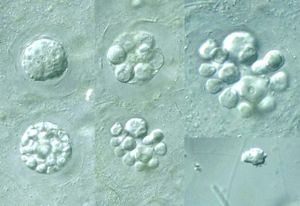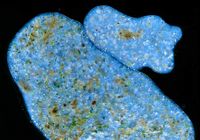Pelobionta
A Microbial Biorealm page on the Pelobionta

Classification
Higher order taxa
Eukaryota
Species
Mastigamoeba balamuthi
Pelomyxa palustris
Pelomyxa corona
|
NCBI: Taxonomy Genome |
Description and Significance
Pelobionta, also known as karyoblasteans, are an amitochondriate amoeboflagellate group, and it has been suggested that they are early eukaryotes. However, placing Pelobionta in a phylogenetic category has proved complicated. While their cytologic features make them appear ancient, rDNA analysis does not place them on early branches. They are large amoebae. Pelobionta are free-living organisms. A new species, Pelomyxa corona, was discovered in 2004 (Frolov et. al.).
Genome Structure
There are multiple species withing Pelobionta, and therefore this classification has many different genome structures. For example, the small subunit ribosomal RNA of the Pelobionta species Pelomyxa palustris is exceptionally long. Analysis of rRNA in P. palustris and other species suggests that Pelobionta emerged after other protists.
Cell Structure and Metabolism
Pelobionta do not have mitochondria. They also lack stacked dictyosomes. Pelobionta are cylindrical in shape. The species Mastigamoeba balamuthi lacks Golgi bodies. However, this does not mean that they lack structures that will perform similar functions. Dacks et. al. (2003) found genes within this species that are homologus to the retromer, coatomer and adaptin complexes, which are related to Golgi bodies. Pelobionta have non-motile flagella whose function is poorly understood; motility is based on pseudopods. The species Mastigamoeba schizophrenia has paired nuclei and basal bodies that lack triplets.
Pelobionta are heterotrophs, feeding on bacteria and small protists.
Pelobionta reproduction incorporates both mitosis and binary fission. The nuclear membrane remains intact throughout division. Duplication produces two chromatids. Then, the microtubule organizing center (MTOC) divides, and microtubules assemble along the new MTOCs. Finally, the cells split.

Ecology

Pelobionta form symbiotic relationships with bacteria; the bacteria serve as a substitute for mitochondira. It is believed that this lack of mitochondria is a secondary absence. There are three different relationships in Pelomyxa species. One bacteria detoxifies oxygen, one metabolizes it, and one removes cellular waste. Pelobionta are able to survive in low-oxygen environments. They are freshwater organisms, and can often be found living in mud. Geographically, Peolbionta are located in temperate regions of the Northern Hemisphere, most commonly in North America. A few species, such as Mastigamoeba balamuthi, are parasites.
References
Hoback, W. Wyatt. Evolution of Early Eukaryotes.
Messing, Charles Garrett. "Protazoa" Classification.
Millot, Jessica. First Eukaryotes.
Patterson, David J. Evolution: A Molecular Point of View.
Patterson, David J. "Parasitic Protists." The Tree of Life Web Project.
Symbiosis and Origin of Eukaryotes.
